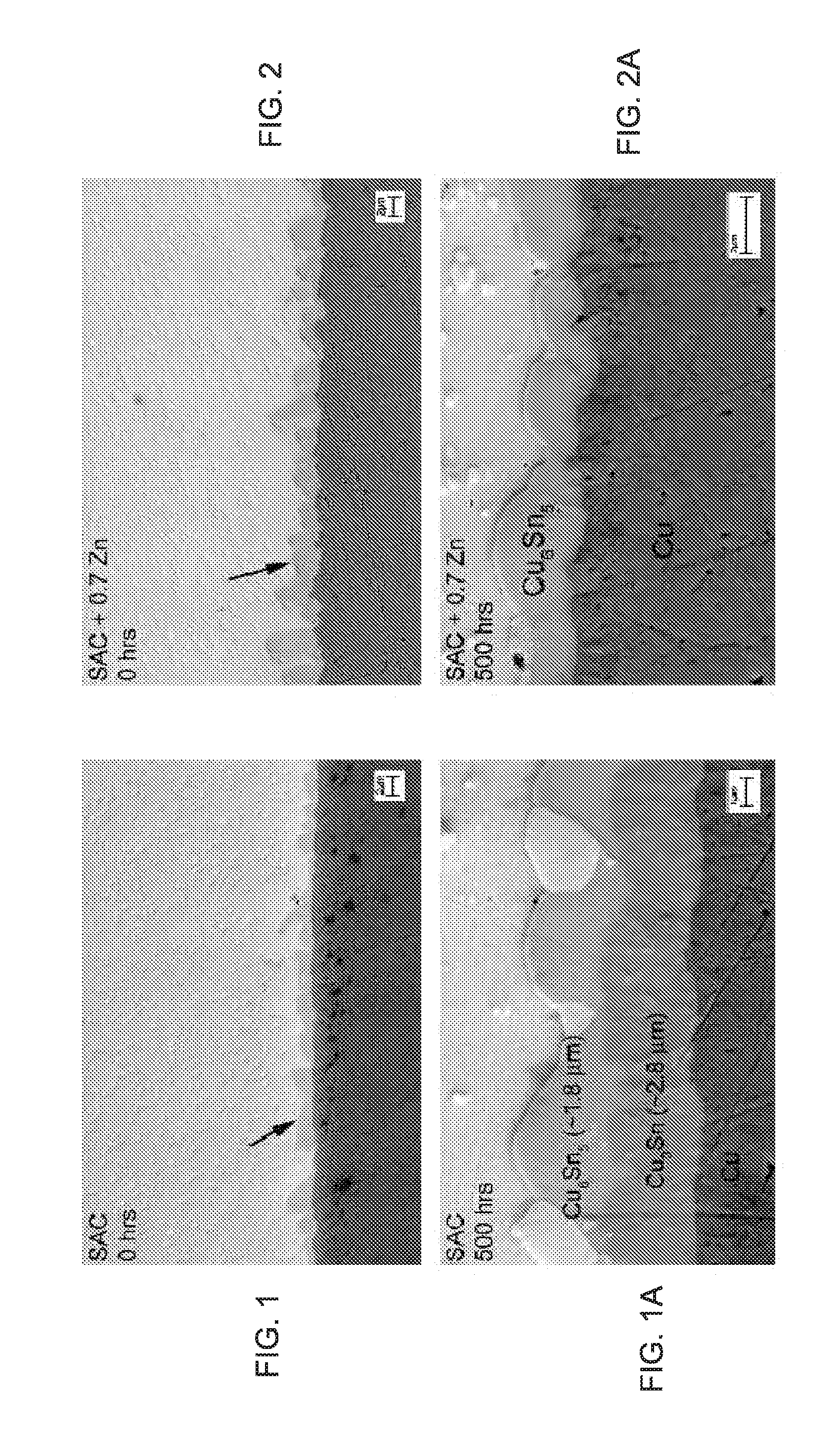Modification of pb-free solder alloy compositions to improve interlayer dielectric delamination in silicon devices and electromigration resistance in solder joints
a technology of pb-free solder alloys and alloy compositions, which is applied in the direction of manufacturing tools, soldering apparatus, transportation and packaging, etc., can solve the problems of interfacial voids and compromise the structural integrity of solder joints, and achieve good mechanical integrity and reliability
- Summary
- Abstract
- Description
- Claims
- Application Information
AI Technical Summary
Benefits of technology
Problems solved by technology
Method used
Image
Examples
example 1
[0052]A 0.025 inch (0.635 mm) diameter solder ball is reflowed on a single 0.022 inch (0.559 mm) diameter Cu pad, voiding is prevented, with only 0.1 wt % Zn in the initial solder ball.
example 2
[0053]A solder joint is created with two opposed Cu pads, using a 0.025 inch (0.635 mm) diameter solder ball and 0.022 inch (0.559 mm) diameter pads, some voiding is found with 0.1 wt % Zn present in the initial solder ball. The outcome with one Cu pad and one Ni pad remains undefined for these ball and pad sizes. But, Zn does react at the Ni pad surface. With 0.3 wt % Zn in the solder and the same ball and pad geometry, voiding is prevented with dual Cu pads. Thus, for these typical BGA situations, generally 0.6 or less % wt Zn is more than adequate to suppress void growth.
[0054]The important metric in this situation is the ratio of the quantity of available Zn in the solder to the pad surface area. This relationship may be expressed in units of grams of Zn per square micron (μ2) of pad area. In the case and associated geometry described above, based on the fact that 0.1 wt % Zn is barely adequate for the ball and pad geometry, with a single Cu pad (but not two pads), and ignoring ...
example 3
[0062]In the case of high-Sn lead containing solders (such as Sn-37Pb) on Cu-based pad structures, excessive pore formation is far from typical. However, in 5-10% of all Cu pad structures, testing leads to severe voiding in the Cu3Sn layer. Moreover, extrapolation of accelerated aging results by means of an empirical Arrhenius dependence may be seen to overestimate “life in service” by a factor of 40 or more, under some circumstances. This situation derives from the fact that the growth rate of the voids can be highly variable and the degree of voiding is seen to depend completely on the nature of the Cu pad and has its origins in the plating process used to create the pad structure. Generally, excessive void formation has not been found when high purity, wrought Cu is used. However, under certain conditions it occurs sporadically with plated Cu structures currently supplied to the electronics industry and leads to solder joint fragility. However, voiding may also be significantly r...
PUM
| Property | Measurement | Unit |
|---|---|---|
| temperature | aaaaa | aaaaa |
| melting point | aaaaa | aaaaa |
| melting point | aaaaa | aaaaa |
Abstract
Description
Claims
Application Information
 Login to View More
Login to View More - R&D
- Intellectual Property
- Life Sciences
- Materials
- Tech Scout
- Unparalleled Data Quality
- Higher Quality Content
- 60% Fewer Hallucinations
Browse by: Latest US Patents, China's latest patents, Technical Efficacy Thesaurus, Application Domain, Technology Topic, Popular Technical Reports.
© 2025 PatSnap. All rights reserved.Legal|Privacy policy|Modern Slavery Act Transparency Statement|Sitemap|About US| Contact US: help@patsnap.com



